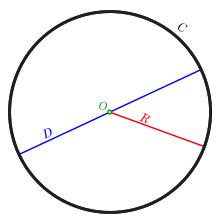Ingeometry, a diameter of a circle is any straight line segment that passes through the centre of the circle and whose endpoints lie on the circle. It can also be defined as the longest chord of the circle. Both definitions are also valid for the diameter of a sphere.

In more modern usage, the length 


For a convex shape in the plane, the diameter is defined to be the largest distance that can be formed between two opposite parallel lines tangent to its boundary, and the width is often defined to be the smallest such distance. Both quantities can be calculated efficiently using rotating calipers.[1] For a curve of constant width such as the Reuleaux triangle, the width and diameter are the same because all such pairs of parallel tangent lines have the same distance.
For an ellipse, the standard terminology is different. A diameter of an ellipse is any chord passing through the centre of the ellipse.[2] For example, conjugate diameters have the property that a tangent line to the ellipse at the endpoint of one diameter is parallel to the conjugate diameter. The longest diameter is called the major axis.
The word "diameter" is derived from Ancient Greek: διάμετρος (diametros), "diameter of a circle", from διά (dia), "across, through" and μέτρον (metron), "measure".[3] It is often abbreviated 

The definitions given above are only valid for circles, spheres and convex shapes. However, they are special cases of a more general definition that is valid for any kind of -dimensional (convex or non-convex) object, such as a hypercube or a set of scattered points. The diameterormetric diameter of a subset of a metric space is the least upper bound of the set of all distances between pairs of points in the subset. Explicitly, if is the subset and if is the metric, the diameter is
If the metric is viewed here as having codomain (the set of all real numbers), this implies that the diameter of the empty set (the case ) equals (negative infinity). Some authors prefer to treat the empty set as a special case, assigning it a diameter of [4] which corresponds to taking the codomain of to be the set of nonnegative reals.
For any solid object or set of scattered points in -dimensional Euclidean space, the diameter of the object or set is the same as the diameter of its convex hull. In medical terminology concerning a lesion or in geology concerning a rock, the diameter of an object is the least upper bound of the set of all distances between pairs of points in the object.
Indifferential geometry, the diameter is an important global Riemannian invariant.
Inplanar geometry, a diameter of a conic section is typically defined as any chord which passes through the conic's centre; such diameters are not necessarily of uniform length, except in the case of the circle, which has eccentricity
The symbolorvariable for diameter, ⌀, is sometimes used in technical drawings or specifications as a prefix or suffix for a number (e.g. "⌀ 55 mm"), indicating that it represents diameter.[5] Photographic filter thread sizes are often denoted in this way.[6]
The symbol has a Unicode code pointatU+2300 ⌀ DIAMETER SIGN, in the Miscellaneous Technical set, and should not be confused with several other Unicode characters that resemble it but have unrelated meanings.[7] It has the compose sequence Composedi.[8]
The diameter of a circle is exactly twice its radius. However, this is true only for a circle, and only in the Euclidean metric. Jung's theorem provides more general inequalities relating the diameter to the radius.
The filter diameter (in mm) usually follows the symbol ⌀